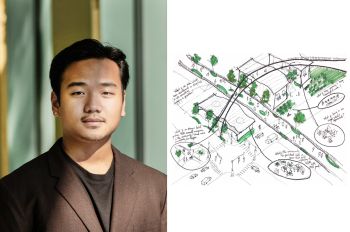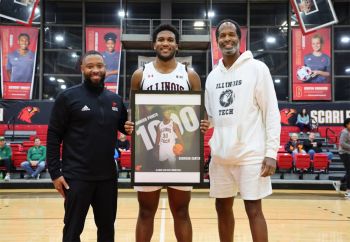Armour R&D Project Aims to Reduce Energy Use to Heat Alumni Hall

Keeping students and faculty toasty in some of the older buildings on Illinois Institute of Technology’s Mies Campus can prove tricky during bitter Midwestern winters, but a group of engineering students is hoping to improve heating efficiency through the support of the Armour R&D program.
Erica Acton (ARCE 3rd year) is one of nine undergraduate students to earn an Armour R&D fellowship. The grant she secured will help fund the Energy Savings for Radiators Using Building Sensors and Controls program at Alumni Memorial Hall. She joins Akram Ali (CE Ph.D. student) and Chris Riley (CE M.S. student) to find the inefficiencies in the steam radiator heating system at Alumni Hall and to devise ways to improve the efficiency of the system.
“The end goal is to prove that we’re using too much steam energy to heat the building,” Acton says. “By analyzing the data, hopefully we’ll see what is the most efficient way to heat each room. Is it on a schedule? Is it based on occupancy? Is it to pre-heat rooms before people arrive?”
Each room is equipped with two sensors designed by Illinois Tech students—one measures the mean radiant temperature of the room and the other senses when the room is occupied or when the lights are turned on. Those sensors communicate with a Raspberry Pi temperature sensor, which operates a control valve, also designed by Illinois Tech students, on each radiator in the building.
A grant from Franklin Energy helped fund the development of the sensors and control valves used in the project. Brent Stephens, director and associate professor of architectural engineering, is the principal investigator of the externally funded program.
Other data collected include a comfort survey filled out by faculty and staff once or twice a week, and photos of the radiators that students will take using an infrared camera to see how much heat is being emitted.
“There are eight different kinds of radiators in this building,” Acton says of Alumni Hall. “Some are cast iron with fins, some are thin tubes. They’re different lengths. Some are stacked and some are not stacked. Some are insulated and some aren’t.”
“Some don’t turn on at all,” says Mohammad Heidarinejad, assistant professor of architectural engineering, Acton’s mentor, and assistant principal investigator of the externally funded program.
“If there is a fault detection, we should be able to find a proper retrofit,” Acton continues.
Heidarinejad can access information from the facilities department to see how much steam is going into Alumni Hall, which is added to the data collection. Once all the data is analyzed, the team can make recommendations to reduce the amount of steam used and still keep the building at a comfortable temperature.
“It’s important to ensure people’s comfort in buildings like this,” Acton says. “And we can find a cheaper solution than retrofitting the entire building to do it.”
Historic Alumni Hall, designed by Ludwig Mies van der Rohe, was built in 1945–46. Updating historic and landmark buildings with modern efficiency standards can be unusually costly in order to maintain the historic value of the structure.
“I like this project because it is campus-focused,” Acton says. “And it might save the university some money if the project goes well.”
The Armour R&D program gives undergraduate students a hands-on experience with research and development unique to Armour College of Engineering each semester. All projects from the 2018–19 academic year will be showcased at the annual Armour R&D Expo on April 18 at 5 p.m. in the John T. Rettaliata Engineering Center.




